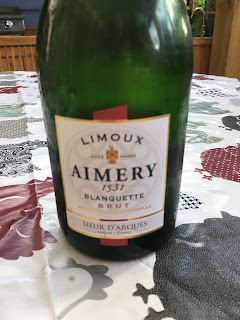So, Who Really Discovered how to make Champagne?
Years ago I sat rather smugly in a restaurant in Epernay,
France consuming a meal built around champagne.
The smugness came from knowing that I was in the coeur of the land of
Dom Perignon, the French monk who discovered the ‘methode champagne’.
I began the meal with Pol Roget, Winston Churchill’s
favorite, moved on to a still wine made from the grapes that are used to make
champagne (Pinot Noir, Pinot Meunier and Chardonnay). After all these years I still remember its slightly malt-like mouth
feel and champagne-like flavor of that still wine.
Then it was on to a couple of other
champagnes - the bubbly kind poured with each course of the meal. And after dessert which was served with yet
another wine came the bill. I still
think it was as a good reason as any for taking out a second mortgage on my
dwelling to settle ‘le addition’.
BTW, in France the word ‘champagne’ may only
appear on the bottle if the grapes used in the wine were grown according to the
appellation rules in specifically designated areas and to be used in the
production of champagne. There is also
that business of the secondary fermentation in the bottle which produces the
bubbles.
So why bring up the subject of
champagne pedigree if it is settled? Aha! Enter the monks from an abbey in Limoux, France. Limoux is in the Languedoc region. I am in the Languedoc region (an official ‘appellation’
of one of many areas which are strictly controlled by a government system. It controls what is permitted to appear on
French wine labels. You will see
Languedoc on a label from here but also showing that it is from a specific
area such as Corbiere.
.
If you recall a few posts back I was in the Macon ‘appelation’. Growers are permitted to add other info to
their labels if approved by the government. For example, you saw a label with Macon on
it. But it also showed Lugny. Lugny is a village, a specific geographic
area in the Macon region. Only wines
labeled Macon followed by Lugny can come from that specific geographic area. But, on with the monks from Limoux.
It seems that brother Perignon was on a pilgrimage from
Epernay to Spain, likely the Camino de Santiago, the Pilgrimage of
Compostela. So the story goes, he
stopped off at the Abbey in Limoux. This
makes sense because monks likely put up other monks for the night on their
journeys. He drank some of the bubbly
and when he returned home he went down into the cellar and got out his test
tubes.
Historically, the first mention of sparkling wine at the
Abbey in Limoux was in 1531. Our brother
Dom Perignon made his first appearance on this planet in 1638 and went to his reward in 1715. You do the math and I will have to take out
another mortgage to pay for a meal in
Limoux.
Now, on to other wine tasting. The Chateau St. Esteve is only a half hour from me. It is one of the premier wine producers in Languadoc. I had the good fortune to taste all its offerings for that day which amounted to about nine wines.
This is a Chateau dedicated to quality above all else. This is evident in their method of pruning the vines to limit production. Beyond that, they go over the grapes by hand picking out individual harvested grapes that do not meet their standards.
It is well worth a look at their website. http://www.chateau-saint-esteve.com/
If it comes up in French you can translate it into English if using Google. Here is the young lady below and the bottles she was kind enough to pour for me to sample. It is amazing after six or eight years in the bottle how their red wine matures into a very well rounded and complex offering.
Here is a close up of one of their labels.
But for me to sample wine I only had to step out the door of my gite and go next door to my neighbor. Here he is with bottles from his vineyard. I sampled four of them and left with a bottle of his rose. It is in the newer style for those of you who hark back to the days of Mateus which came from Portugal. The roses today are a bit less sweet, more tart on the finish.

Finally, I end this post with a couple of pictures for Toby. Look at the first one which shows a drain pipe coming down the side of a house.








Comments
Post a Comment